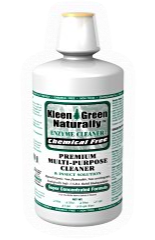- Home
- Bed Bugs - Natural Ginesis
Bed Bugs - Natural Ginesis




| Common Name | Scientific Name | TESTIMONIAL "Thank you. We seem to be rid of the bed bugs and the roaches also. HH - California |
| Bed Bug | Cimex lectularius | |
| Tropical Bed Bug | Cimex hemipterus |
Little Vampires of the Insect World
Click the 'Play' Button (if you dare) to see a time-lapse video of the Blood-Sucking Bed Bug feasting on it's Human victim... Research Video Courtesy of the University of Kentucky. Copyright (c) University of Kentucky - Used by Permission.
"I was living out the scene of some Sci-Fi thriller where bugs would feast on my flesh in the night. Then the Manhattan newspapers came out with an article claiming that the city was at an all time high infestation of bed bugs, affecting people in all income brackets and even residing in high-end hotels..."
-Click here to read more Kleen Green product testimonials.
Bed bugs have invaded homes even five star hotels with a vengeance and at lightning speed. These grisly little nocturnal bugs only come out at night searching for a blood meal. Their residence is our beds and bedrooms.
These creepy crawling night stalkers feast and feed by sucking human blood. They pierce the skin with their elongated beak -like a hypodermic needle. Bed bugs inject their victims with their saliva, which contains a numbing agent, like Novocain. They drink until they become engorged with a person's blood - crawling away satisfied - until the next night.
The common bed bug (Cimex lectularius Linnaeus): They "glue" their eggs in the hiding places. The nymphs hatch in about ten days and molt five times, taking a blood meal between each molt. The life cycle from egg to adult varies between 36 and 120 days. This life span depends on conditions as nymphs can survive long periods of starvation - up to a year!
Tips for Bed Bug Removal in the Home
- They cannot crawl up smooth surfaces. Remove bed-skirt if you have one. Coat legs of bed with light coating of Vaseline or cooking oil - or place legs of bed in glass or plastic containers.
- IRON your mattress - especially the edges!
- After misting mattress with Kleen Green Enzyme cleaner - wrap mattress in plastic.
- Wash and/or dry bedding and towels - daily if necessary.
- Use small amount (about 1/2 oz.) of Kleen Green in a steam vac for superior cleaning.
- Persistence in spraying daily may be necessary for several days.
- Use vacuum attachments to clean cracks and crevices. Caulk or seal these openings permanently.
- Inspect dresser drawers - wash and/or dry clothing if necessary.
- Use canned air or hair dryer on high hot heat to 'blow out' tight areas such as ornate wood headboards.
- TIP: Plumbing or radiator type heaters with piping in the floor is an entrance into your apartment from another apartment for bedbugs. Secure any space around plumbing or heating elements with caulking, aluminum foil or steal wool to prevent these travelers coming into your apartment/condo.

Why and How Kleen Green™ Works
Insects are made up of a high concentration of protein. When Kleen Green is introduced to the insect, the enzymes act and can cause the insect to molt (shed its outer coating) prematurely. Poison pesticides attack the nervous system of the insect, which is not always effective. University research has noted that some insects have developed a resistance to poison based products. This revolutionary product is now available to the general consumer. Preformed enzymes have been used widely in restaurant and institutional settings for the last ten years, due to their low toxicity and superior cleaning properties. They are also becoming widely accepted in the field of pest cleaning as enzymes leave no toxic residues and the enzymatic effect on the insect exoskeleton is quick and safe. SAFE for Gardens, Plants, Ponds and around children and pets!
A Natural Alternative to Toxic Products
- Fast Acting
- Does Not Produce Toxic Fumes
- Extremely Economical
- More Effective and Safer than Pesticides!
Kleen Green: Non-Toxic, Pesticide Free Spray
Super Concentrated - Pesticide Free
- 8 oz makes 2 quarts
- 16oz makes 4 quarts
- 32oz makes 8 quarts
- 64 oz makes 16 quarts
- 128oz makes 32 quarts
- Also available in 5 gallons
THE MOST SUPERIOR NON-TOXIC REMEDY ON THE MARKET TODAY
| INGREDIENTS: Active ingredients: A specially formulated broad spectrum of NATURAL enzymes (protease, amylase, cellulose, lipase) derived from innocuous yeast strains. FDA good grade ingredients. GRAS (FDA Generally Regarded As Safe) List Parts 184 and 186. This product is not a pesticide. |
How to use Kleen Green™ Enzymes
- This nontoxic product provides superior cleaning in the entire home eradicating and digesting dirt, bacteria and microscopic mites - even dust mites.
- Spray and/or mist cracks, crevices, around window and door frames daily for several days. Persistence and patience will give the best results when using Kleen Green. No need to leave your home like that with pesticides. Kleen Green does not produce any toxic fumes. Kleen Green Enzymes eliminates offensive odors.
- Safe to spray on all surfaces: carpet, bedding, walls, floors and furniture.
- Kleen Green may be used in the laundry and in carpet cleaning machines.
- Pour 1oz. of concentrate directly into wash load without detergent for a fresh clean laundry.
- TIP: Kleen Green is safe to use in humidifiers. Pour 2 to 4 oz. into your humidifier for eliminating odors and controlling air born bacteria, germs and pests.
How to Use Kleen Green for Treating Bed Bugs:
- Spraying with Kleen Green instantly cleans away bed bugs!
- Apply a light mist to the entire mattress. Pay particular attention in spraying mattress seams, buttons and tears. Don't forget to treat the bottom of the mattress, box springs and bed frame.
- The objective is not the quantity of spray used, but rather the proper placement of the enzyme cleaner.
- Spray Kleen Green into cracks, crevices and corners! BE THOROUGH.
- Inspect and spray along baseboards, window frames, wall paper edges, heat registers and other moldings. As it may be impossible to penetrate all hiding places immediately, control may not be immediate and bugs may be seen for several days after treatment.
- Vacuum thoroughly. Check behind pictures, drapes, wall sockets and even closets.
- ATTENTION APARTMENT/CONDO RESIDENTS: Plumbing and heating pipes are like a freeway for a bed bug! Caulk or seal any space around plumbing pipes. Then vacuum and spray Kleen Green liberally all cracks, crevices and corners.
- On Guard Bug Dust (nontoxic diatomaceous earth) provides a powerful residual. Death is within 24 hours. Apply to any crack, crevice or corner. Safe on beds
Tips for Travelers
- Examine the hotel/motel room by pulling the bed covers down. If you see moving or crawling pests, or if you see dark spots on the sheets, request to be moved to another room immediately.
- Look for small blackish or reddish colored dots - this is their fecal dropping.
- Bed bugs are not parasites - a crawling bed bug on the skin can be easily removed by hand.
- Bed bugs will hide anywhere - the night-stand, carpeting, drawers, headboards, behind pictures and drapes.
- Check your clothing, luggage and shoes before you leave the hotel.
- Vacuum your suitcases and spray with Kleen Green before bringing them into the house.
- Consider packing a large lawn/leaf plastic bag. Encase and tie up your luggage in the bag while in a hotel room.
- Great as a bed linen spray and bed bug spray for travelers.
Attention Hotels and Motels
- Use nontoxic Kleen Green as part of your daily cleaning routine for prevention.
- Provides superior chemical and pesticide free cleaning.
- "Bug Bombs" or total release aerosol insecticides for bed bugs is NOT effective!
- Avoid the use of pesticides or insecticides if at all possible.
- Never apply insecticides or pesticides to bedding (sheets, blankets, bed spreads)! [asthma]
Bed Bug Facts
- Bed bugs are annoying and persistent. Getting rid of them requires persistence.
- Bed bugs hide in extremely small cracks, crevices and corners, making it difficult to locate breeding sites.
- These vampires of the insect world venture from their hiding spots at night.
- Life Span! Bed bugs can live a year or longer without food (blood) and thus stay in their hiding places.
- Bed bugs can travel long distances and survive in suitcases, clothing, vehicles, aircraft, and cruise ships.
- Bed bug females lay about 300 eggs.
- Bed bugs hatch from eggs in 10 days....
Where do they hide?
- In early infestations the bedbugs are found only about the tufts, seams, and folds of mattresses and daybed covers; later they spread to cracks and crevices in the bed and mattresses.
- If allowed to multiply, they can be found behind baseboards or woodwork, window and door frames, pictures, and moldings, and in furniture, loosened wallpaper, and cracks in plaster and partitions.
- OTHER HIDING PLACES: Mattresses Box Springs, Wall Sockets, Old Books and Papers, Behind Wallpaper, Clothing, Dresser Drawers, Behind Curtains and Drapes, Cracks, Crevices or Corners of Floors or Walls, Upholstered Furniture, Day Beds, Behind Pictures, Covers and Bedspreads.
What happens when they bite?
- The reaction to bed bug bites varies, from no reaction to severe skin inflammation, irritation and itching.
- A small, hard, swollen, white welt may develop at the site of each bite. Severe itching can lasts for several hours to days at the irritated, inflamed bite area.
- A bedbug generally feeds at night, but if it is hungry and the area has a dim light, it may feed during the day.
- If left undisturbed, a full-grown bedbug becomes engorged with blood in 3 to 5 minutes. It then crawls into hiding, remaining there for several days to digest its meal. When hunger returns, the bug emerges from hiding and seeks another blood meal.
They Feed On Humans
- While bedbugs feed primarily on humans, they also feed on other mammals, poultry, and other birds. Their host range is confused by the fact that the insect family Cimicidae, of which the common bedbug is a member, has several closely related species with similar habits and appearance.
- They are spread mainly by clothing and baggage of travelers and visitors, secondhand beds, bedding materials, furniture, laundry and even moving company blankets. Nesting birds, rodents, squirrels, poultry can be carriers and can enter through open windows.
- The mature bedbug is a brown-to mahogany-colored, wingless insect. Its size depends on how recently it has eaten a blood meal. An unfed bed bug is between 1/4 and 3/8 inches long. The upper surface of its body has a papery, crinkly, flimsy appearance. When engorged with blood, its body becomes elongated and swollen, and its color changes from brown to dull red. The color, size, and shape change from an unfed to a full bug is remarkable.
- Bedbug eggs are white and about 1/3-inch long. Under favorable conditions the female bedbug lays about 200 eggs at the rate of 3 or 4 per day. Eggs have a sticky coating and stick to objects where they are laid. It usually takes the eggs 6 to 17 days to hatch, and the newly emerged nymphs will feed immediately. A bedbug goes through five molts (shedding of its skin) before it reaches maturity. Depending on environmental factors and the availability of food, there can be considerable variation in developmental rate.
- Bedbugs may live for several weeks to several months without feeding, depending on temperature.
Bloods Spots on Sheets and Sickly Sweet Odor
Heavily used hiding places are evident by black or brown spots of dried blood excrement on the surfaces where the bugs rest, like your bed. Eggs, egg shells, and cast skins may be found near these places. Usually there is an offensive sickly sweet odor where bedbugs are numerous.
Most bug problems are not detected until someone has been bitten. A bed bug infestation can be recognized by blood stains from crushed bugs or by blood (sometimes dark) spots of their droppings on sheets and mattresses, bed clothes, and walls. Fecal spots, eggshells, and shed skins may be found in the vicinity of their hiding places. An offensive, sickly sweet, musty odor from their scent glands may be noticeable with severe bed bug infestations.
Disclaimer
All Natural Ginesis products are safe and non-toxic when used as directed. Natural Ginesis is not a substitute for medical advice. The operators of this website and those who provide information for this site do not directly or indirectly practice medicine or dispense medical advice or services through this website. You should not rely on this information to determine a diagnosis or course of treatment, nor should it be considered a replacement for consultation with a physician or other certified healthcare provider. Natural Ginesis and its distributors do not make representations or warranties with respect to any information offered or provided on or through any company web sites regarding treatment, action or application of product. Neither Natural Ginesis nor any of its divisions or contributors shall have any liability for the content, errors or omissions in the information provided by this web site. Neither Natural Ginesis nor its distributors are responsible or liable for any advice, course of treatment, diagnosis, or any other information, services or products that you obtain through this site. Those with health problems, pregnancy or who are nursing are specifically advised that they should consult their physician before taking any nutritional supplement.
Thank You!
 Loading... Please wait...
Loading... Please wait...






 South Africa
South Africa